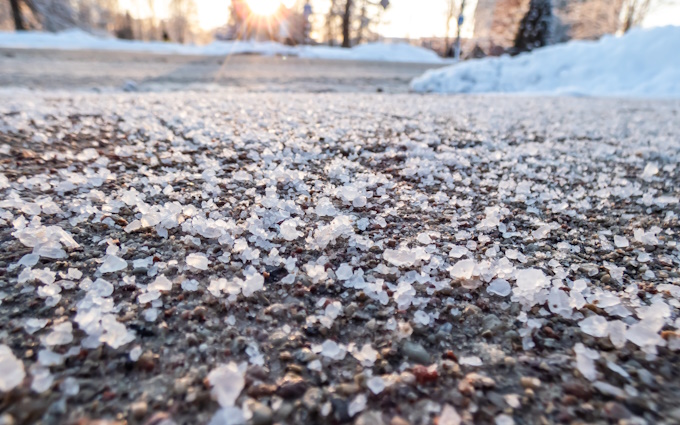You Can Avoid Tree Damage by Using These Arborist-Approved Cold Weather Tips
Slick surfaces and black ice pose a threat to drivers and pedestrians in the winter, which is why it’s become common practice to use de-icing salts on roadways, driveways, sidewalks, and walkways.
While these salts are crucial for human safety, they pose a significant threat to our leafy companions: trees. Understanding the implications of de-icing salts and implementing protective measures is essential to ensure their well-being.
As any certified arborist will tell you, homeowners should use extreme caution when applying de-icing salts to their property. In this blog, we’ll explore what de-icing salts do to trees and what you can do to avoid negative effects. By following these tips, you can avoid needing to make an appointment with an arborist and tree surgeon for rehabilitation services.
What Are De-Icing Salts?
De-icing salts are primarily composed of sodium chloride. They may also contain calcium chloride, magnesium chloride, and potassium chloride. De-icing salt has a lower freezing point compared to water, preventing the formation of hazardous ice patches and promoting safer travel. For best results, de-icing salts should be applied before things freeze over.
Impact of De-Icing Salts on Trees
Although de-icing salts contribute to human safety, arborists want homeowners to be aware of their effects on trees, as they are often overlooked. The salts can disrupt the delicate balance within a tree’s root system and soil structure, leading to a cascade of negative consequences, like:
- Soil dehydration: De-icing salts interfere with the soil’s ability to retain moisture. This dehydration can be detrimental to trees, causing them to struggle to replenish lost water during the winter months.
- Nutrient imbalance: De-icing salts can alter the nutrient composition of the soil, affecting the availability of essential elements like potassium and calcium. This imbalance hinders a tree’s ability to absorb nutrients, leading to weakened health and vitality.
- Root damage: The salts can damage tree roots, causing lack of moisture and inhibiting nutrient uptake. This weakened root system compromises the tree’s stability and overall well-being. Homeowners will need to consult with an arborist near them to see what their options are to care for trees affected by salts.
- Leaf burn: Contact between de-icing salts and tree foliage can result in leaf burn. The edges and tips of leaves may turn brown, affecting the tree’s aesthetics and reducing its ability to photosynthesize.
- Stem and bud damage: Salt-laden runoff water can splash onto stems and buds, causing what arborists refer to as “spray zone injuries.” This damage can inhibit new growth and compromise the tree’s ability to produce leaves and flowers in the upcoming seasons.
Protecting Trees from De-Icing Salts: Practical Measures
De-icing salts are key for maintaining safe surfaces in the winter, so we don’t expect homeowners to stop using them. For those who wish to avoid salt-related tree issues, refer to the following arborist-approved tips:
- Select salt-tolerant trees: When possible, choose tree and plant species that exhibit a higher tolerance to de-icing salts. A certified arborist can help you with your selection.
- Create physical barriers: Physical barriers help shield trees from direct exposure to salt-laden runoff. This helps minimize contact between the salts and the tree’s root system. When creating a barrier system, it’s best to stick with wood or burlap.
- Mulch as a protective layer: Apply a layer of organic mulch around the base of trees to help retain moisture, regulate soil temperature, and reduce the impact of de-icing salts on the soil.
- Do not use de-icing salt in excess: Did you know that one teaspoon of salt will contaminate five gallons of water? A little goes a long way, so use de-icing salts sparingly. In addition to helping protect your trees, this tip also reduces pavement corrosion.
- Use alternatives to rock salt: Explore alternative options that are less harmful to trees and still provide effective ice melting. Sand, kitty litter, and calcium chloride are a few options you can try. Plus, they mitigate the need to seek the help of an arborist and tree surgeon.
- Wash away residues and treat the soil for contamination: Homeowners should spray down any trees that have salt residue on them with water. Soil that has been contaminated due to prolonged exposure to salts can be treated using powdered gypsum, which promotes soil movement and solubility.
Find the Balance Between Safety and the Well-Being of Your Trees
This winter, homeowners should strike a balance between their winter safety measures and the well-being of their trees. By using arborist-approved best practices and exploring alternative options, you can get the best of both worlds.
Protecting the purity of your soil this winter promotes long-term tree health and great curb appeal. Of course, if you’re noticing issues with your trees that may be related to de-icing salt, it’s best to contact a tree specialist or an arborist in Kansas City. There are measures they can take to help rehabilitate your trees and soil health.

